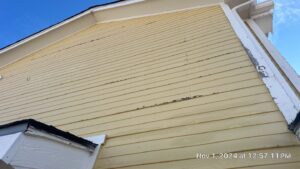How to Spot Early Signs of Wear and Tear on Painted Surfaces
Paint does more than just add color to your home—it protects surfaces from moisture, UV rays, and daily wear and tear. Recognizing the early signs of paint deterioration can help you address minor issues before they turn into costly repairs. Here are some key things to look for to keep your home’s painted surfaces in top shape.
1. Cracking or Flaking Paint
- What to Look For: Cracking and flaking are some of the most common early signs of paint wear. You may notice small cracks forming on walls, trim, or exterior siding, which can eventually start to flake off.
- Why It Happens: This often occurs due to age, exposure to extreme weather, or poor surface preparation before painting. In Denver’s fluctuating climate, temperature changes can put extra stress on exterior paint, leading to these issues.
- How to Address It: If you notice early cracking, it may be time to consider a new coat of paint to prevent further damage. Whether doing it yourself or hiring a professional painter, make sure the areas with cracking or flaking paint are properly prepped.
2. Fading or Discoloration
- What to Look For: Fading often appears as dullness in color or uneven patches. Fading is most commonly found in areas exposed to direct sunlight.
- Why It Happens: Over time, UV rays cause paint to break down and lose its original color. In high-altitude cities like Denver, where the sun’s intensity is stronger, fading can happen faster than in other climates.
- How to Address It: Sherwin Williams and Benjamin Moore have great UV-resistant paints designed to reduce fading. If it’s already visible, a fresh coat with a protective finish might be necessary to restore vibrancy.
3. Peeling or Bubbling
- What to Look For: Peeling or bubbling paint creates an uneven surface where the paint appears to lift or separate from the wall or siding.

- Why It Happens: Peeling is often due to moisture getting under the paint layer. This is especially common in bathrooms or on exterior walls exposed to rain and snow.
- How to Address It: Check for sources of moisture, like leaks or poor ventilation. Small areas can often be touched up, but extensive peeling may require a full repaint.
4. Chalky Residue
- What to Look For: Chalkiness on exterior paint leaves a fine, powdery residue that can easily rub off onto your hand when touched.
- Why It Happens: Chalking results from paint breaking down over time. UV rays and rain are common culprits.
- How to Address It: Light chalking can be cleaned off, but if it persists, it may indicate your home is due for a new coat of paint.
5. Mold or Mildew Spots
-
What to Look For: Mold or mildew often appears as dark spots or patches, typically in areas with high moisture, like bathrooms or shaded outdoor spots.
-
Why It Happens: Excess moisture or lack of ventilation promotes mold and mildew growth.
-
How to Address It: Use a mild cleaner to remove any spots you find. Persistent mold may be a sign of a larger moisture issue. Be sure to have a professional evaluate the situation.
6. Small Holes or Dings
-
What to Look For: Over time, walls can accumulate small holes, scuffs, or dings from daily life—especially in high-traffic areas or where furniture is frequently moved.
-
Why It Happens: Minor wall damage is inevitable, but when left unchecked, these small issues can worsen and impact the paint’s integrity.
-
How to Address It: For small dings, use spackle to fill in gaps, and touch up with matching paint. Larger damage may require drywall repair, sanding, priming, and repainting the area.
When to Call a Professional
Noticing these early signs of wear and tear doesn’t necessarily mean you need to repaint your whole home—but it’s a good idea to address problem areas sooner rather than later. A professional assessment can help you determine if you need a touch-up, a complete repaint, or other protective measures to extend the life of your painted surfaces.
At Helix Painting, we specialize in quality, long-lasting paint applications designed to withstand Denver’s unique climate. Reach out to us for a consultation or to schedule an estimate. Protecting your home’s paint is an important way to keep it looking beautiful and maintain its value over the long term.
Contact us for a consultation or quote today.


